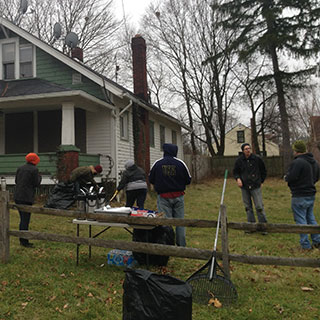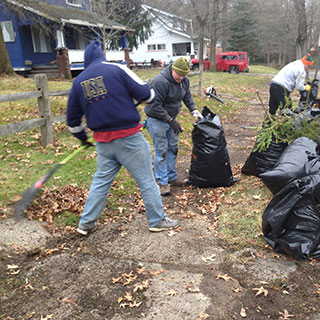Here's a look back at some of the notable news of 2014 in Youngstown:
1. Youngstown Gets A New Plan: Deteriorating physical and social fabric have long been an issue for Rust Belt cities like Youngstown. Urban sprawl, a decline in manufacturing and the depletion of the public school system are all major factors which have contributed to the problem.
Social statistics bear this out yet they are often met with mixed results. For instance, in 2014, Youngstown saw a 31% decrease in violent crime by mid-year and a lower homicide than 2013. And while the Valley's unemployment rate was the lowest it's been in 14 years (4.9% as of November), the city's was slightly higher at 6.9% but down from 9.8% a year ago.
However, in September, the U.S. Census Bureau released figures which indicated that Youngstown's poverty rate remains exceptionally high at 40.2%, placing it among the top six cities in the nation in that category. Not surprisingly, it was also reported that the child poverty rate in the Youngstown School District was also double the national average.
Over time, the fallout from these social ills can leave some areas of the city in a condition which is often greater than what residents, the city or business are able to fix by themselves. This is where planning and community development initiatives play an important role.
Ten years ago, Youngstown drafted an ambitious plan - titled 'Youngstown 2010' - which sought to 'right-size' the city. While it didn't lack vision, it did largely lack detail as well as the capacity (people and funding) to implement it.
However, a great deal of progress has been made on this front in recent years. Perhaps the most notable has been the efforts of the Youngstown Neighborhood Development Corporation.
In 2014, the organization completed a new (and much more pragmatic) plan for neighborhood development in the city. The plan was preceded by nearly 5 years of nationally and internationally recognized work.
As a result, YNDC was recognized as the '2014 Ohio Community Development Corporation Of The Year' by the Ohio Community Development Corporation Association.
Having now had time to see what the organization is capable of accomplishing, implementation of the current plan should perhaps be met with a healthier degree of optimism than those plans and initiatives of the past.
2. Downtown Development Continues: The revitalization of downtown Youngstown continued to take major strides in 2014.
The Kress Building and Wean United were lost to the wrecking ball but other major projects such as the redevelopment of the Wick, Wells and Gallagher buildings took big steps forward. Some if not all are scheduled for completion in 2015.
Perhaps the biggest news on this front was the announcement of plans for a Doubletree Hotel by Hilton in central square's historic Stambaugh Building. The 125-room hotel will feature conference space as well as fine dining and retail. Completion is scheduled for 2016.
New restaurants such as Suzie's Dogs & Drafts, Ryes, Christopher's Downtown and the Youngstown Doughnut Company opened their doors while the Erie Terminal Building also created a first-floor art gallery and community event venue (Nove Gatto). Other businesses such as The 5th Floor (formerly The Youngstown Club) and A&C Beverage announced plans for 2015.
In other news, downtown community development organizations Youngstown Cityscape and Wick Neighbors merged in an effort to maximize their collective impact; Youngstown State began assistance with creation of a downtown economic action group/plan; a new city events & marketing director was hired; the Covelli Center was on pace to have its best financial year yet; and the Youngstown Business Incubator continued its rapid expansion while also being named the No. 1 university-affiliated incubator in the world.
3. Changes At City Hall: 2014 marked Year One for new mayor John McNally.
In his campaign, McNally vowed to work closely with neighborhood groups; develop a more strategic demolition & development strategy; initiate efficient government measures; and play a more active role in the city school system.
He also opened the mayor's door to the public with a monthly segment titled '5 Minutes With The Mayor' and became the first mayor to use social media as a tool for community engagement.
However, in May, the State of Ohio reissued indictments related to the 2006 county purchase of Oak Hill Renaissance Place. The indictments included McNally who, at the time, was a County Commissioner. A trial is scheduled for 2015.
In other City Hall news, Youngstown City Council finally approved a new map for the city's seven ward system. It had been over 30 years since council redistricted its wards and over two years since voters approved a charter amendment mandating that it be done.
The delay prompted a citizens group to place an initiative on the November ballot which would have based the city's wards on population while also ensuring that redistricting be done every Census if necessary. In what turned out to be a highly charged campaign, the measure lost by less than 1% of the vote.
The city also continued to gather more national exposure in 2014. In January, Youngstown received a second State of the Union shoutout while The New York Times, Forbes, and CNBC each featured the city in various stories or reports.
4. Even Bigger Changes At YSU: It was also a year of big change at Youngstown State University.
In February, President Randy Dunn announced that he would be resigning as YSU president after only seven months on the job in order to assume the presidency of Southern Illinois University.
The news came as a shock to the community and resulted in a lobby by numerous local leaders to hire Jim Tressel as Dunn's replacement. The campaign was effective and Tressel was selected as the ninth president of the university in May.
Tressel's first six months would come with some turbulence. With the university already facing a multi-million dollar deficit due to a combination of cuts in state funding as well as declining enrollment, layoffs were issued in June and a faculty contract was rejected in November, setting the stage for a possible showdown in 2015.
Academically, YSU's programs in counselling and materials analysis received regional and national recognition; the school's first patent was issued; and ribbons were cut on a Center For Innovation In Additive Manufacturing as well as a new veterans resources center.
The YSU Foundation surpassed $225 million in assets in 2014, placing it the top third of university endowments throughout the nation and the largest in northeast Ohio. In mid-December, the Board of Trustees authorized the foundation to assume all fundraising functions for the school.
Having failed to make the playoffs in his first 5 seasons and faced with declining fan support, YSU head football coach Eric Wolford was released. He was replaced by Youngstown native and former Nebraska head coach Bo Pelini in a shocking move that made national headlines.
Pelini (a Cardinal Mooney graduate) will face new University of Pittsburgh head coach Pat Narduzzi (an Ursuline & YSU graduate) on September 5th in what will be the first game for both coaches with their new programs.
Also in 2014, YSU won titles in men & women's outdoor track, baseball, women's tennis and women's cross country; the women's basketball team was off to its best start in Division I program history; and the men's team - while in a rebuilding year of sorts - exceeded expectations and earned 9 wins before the start of conference play in January.
Also, football player Chris Elkins and basketball players Damian Eargle, Kam Belin and Kenrick Perry signed professional contracts to continue their athletic careers.
---
Youngstown was filled with ups and downs in 2014. However, there were some major accomplishments on multiple fronts that will likely lay the groundwork for serious progress in the years to come. Here's to a prosperous 2015.
To read the full story from Defend Youngstown, click here.
 ,
, 
 ,
, 
 ,
, 